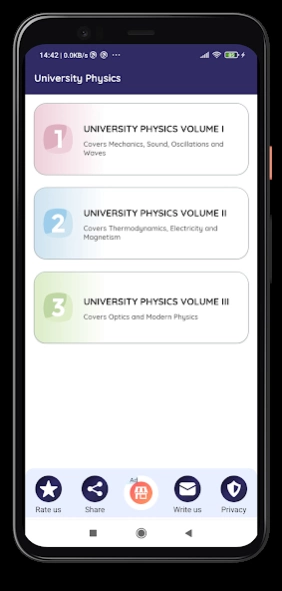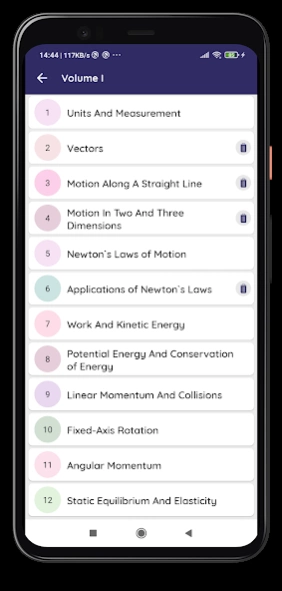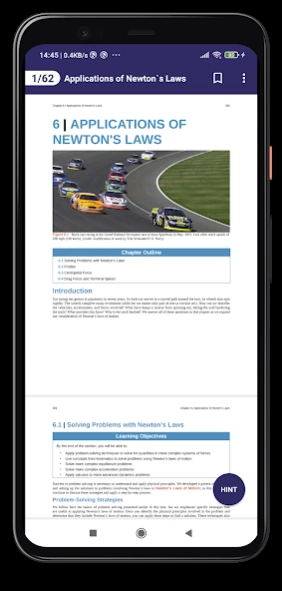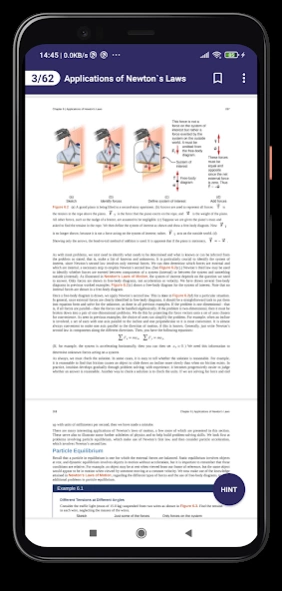University Physics 1.0.8
Free Version
Publisher Description
University Physics - University Physics Volume 1, Volume 2 and Volume 3 Textbook and MCQ
University Physics is a three-volume collection that meets the scope and sequence requirements for two- and three-semester calculus-based physics courses.
Volume 1: covers mechanics, sound, oscillations, and waves.
Volume 2: covers thermodynamics, electricity and magnetism.
Volume 3: covers optics and modern physics.
This app emphasizes connections between theory and application, making physics concepts interesting and accessible to students while maintaining the mathematical rigor inherent in the subject. Frequent, strong examples focus on how to approach a problem, how to work with the equations, and how to check and generalize the result.
👉 Course overview:
✔ Multiple Choices Questions (MCQ)
✔ Essay Questions
✔ Solution
✨Content of The Application✨
Unit 1. Mechanics
1. Units and Measurement
1.1. The Scope and Scale of Physics
1.2. Units and Standards
1.3. Unit Conversion
1.4. Dimensional Analysis
1.5. Estimates and Fermi Calculations
1.6. Significant Figures
1.7. Solving Problems in Physics
2. Vectors
2.1. Scalars and Vectors
2.2. Coordinate Systems and Components of a Vector
2.3. Algebra of Vectors
2.4. Products of Vectors
3. Motion Along a Straight Line
3.1. Position, Displacement, and Average Velocity
3.2. Instantaneous Velocity and Speed
3.3. Average and Instantaneous Acceleration
3.4. Motion with Constant Acceleration
3.5. Free Fall
3.6. Finding Velocity and Displacement from Acceleration
4. Motion in Two and Three Dimensions
4.1. Displacement and Velocity Vectors
4.2. Acceleration Vector
4.3. Projectile Motion
4.4. Uniform Circular Motion
4.5. Relative Motion in One and Two Dimensions
5. Newton's Laws of Motion
5.1. Forces
5.2. Newton's First Law
5.3. Newton's Second Law
5.4. Mass and Weight
5.5. Newton’s Third Law
5.6. Common Forces
5.7. Drawing Free-Body Diagrams
6. Applications of Newton's Laws
6.1. Solving Problems with Newton’s Laws
6.2. Friction
6.3. Centripetal Force
6.4. Drag Force and Terminal Speed
7. Work and Kinetic Energy
7.1. Work
7.2. Kinetic Energy
7.3. Work-Energy Theorem
7.4. Power
8. Potential Energy and Conservation of Energy
8.1. Potential Energy of a System
8.2. Conservative and Non-Conservative Forces
8.3. Conservation of Energy
8.4. Potential Energy Diagrams and Stability
8.5. Sources of Energy
9. Linear Momentum and Collisions
9.1. Linear Momentum
9.2. Impulse and Collisions
9.3. Conservation of Linear Momentum
9.4. Types of Collisions
9.5. Collisions in Multiple Dimensions
9.6. Center of Mass
9.7. Rocket Propulsion
10. Fixed-Axis Rotation
10.1. Rotational Variables
10.2. Rotation with Constant Angular Acceleration
10.3. Relating Angular and Translational Quantities
10.4. Moment of Inertia and Rotational Kinetic Energy
10.5. Calculating Moments of Inertia
10.6. Torque
10.7. Newton’s Second Law for Rotation
10.8. Work and Power for Rotational Motion
11. Angular Momentum
11.1. Rolling Motion
11.2. Angular Momentum
11.3. Conservation of Angular Momentum
11.4. Precession of a Gyroscope
12. Static Equilibrium and Elasticity
12.1. Conditions for Static Equilibrium
12.2. Examples of Static Equilibrium
12.3. Stress, Strain, and Elastic Modulus
12.4. Elasticity and Plasticity
13. Gravitation
13.1. Newton's Law of Universal Gravitation
13.2. Gravitation Near Earth's Surface
13.3. Gravitational Potential Energy and Total Energy
13.4. Satellite Orbits and Energy
13.5. Kepler's Laws of Planetary Motion
13.6. Tidal Forces
13.7. Einstein's Theory of Gravity
14. Fluid Mechanics
14.1. Fluids, Density, and Pressure
14.2. Measuring Pressure
14.3. Pascal's Principle and Hydraulics
14.4. Archimedes’ Principle and Buoyancy
14.5. Fluid Dynamics
14.6. Bernoulli’s Equation
14.7. Viscosity and Turbulence
Unit 2. Waves and Acoustics
15. Oscillations
15.1 Simple Harmonic Motion
15.2 Energy in Simple Harmonic Motion
15.3 Comparing Simple Harmonic Motion and Circular Motion
15.4 Pendulums
15.5 Damped Oscillations
15.6 Forced Oscillations
16. Waves
17. Sound
About University Physics
University Physics is a free app for Android published in the Teaching & Training Tools list of apps, part of Education.
The company that develops University Physics is RK Technologies. The latest version released by its developer is 1.0.8.
To install University Physics on your Android device, just click the green Continue To App button above to start the installation process. The app is listed on our website since 2024-03-07 and was downloaded 1 times. We have already checked if the download link is safe, however for your own protection we recommend that you scan the downloaded app with your antivirus. Your antivirus may detect the University Physics as malware as malware if the download link to com.rktech.universityphysicsvolone is broken.
How to install University Physics on your Android device:
- Click on the Continue To App button on our website. This will redirect you to Google Play.
- Once the University Physics is shown in the Google Play listing of your Android device, you can start its download and installation. Tap on the Install button located below the search bar and to the right of the app icon.
- A pop-up window with the permissions required by University Physics will be shown. Click on Accept to continue the process.
- University Physics will be downloaded onto your device, displaying a progress. Once the download completes, the installation will start and you'll get a notification after the installation is finished.



